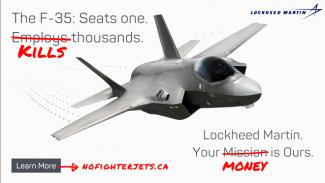NO JET BET
Billions for jet fighters last thing Canada should spend on

“You cannot simultaneously
prevent and prepare for war.
— Albert Einstein, 1946 —
“I’M LIVING WITH WAR EVERY DAY” is not just a line from the 2006 Neil Young song. It was a reality for all of us then. It is a reality for all of us today. A July 14 open letter asks Prime Minster Trudeau to recognize that reality and reject it.
The letter from the Canadian Foreign Policy Institute and the Canadian Voice of Women for Peace asks Trudeau to cancel plans to spend billions to buy 88 new fighter jets. Singer/songwriter Neil Young signed the letter along with more than 100 well-known peace activists including: David Suzuki, Elizabeth May, Naomi Klein, Chris Hedges, Judy Rebick, Yves Engler and Noam Chomsky.
Last priority for most of us
Polls show Canadians are not keen to have us buy more warplanes. An October 2020 Nanos poll revealed that bombing campaigns are an unpopular use of the military and supporting NATO and ally-led missions is a low priority.
The majority of Canadians said that peacekeeping and disaster relief was a priority, not preparing for war.
Canada’s stated rationale for buying new warplanes is that: “A modern fighter jet fleet is essential for defending Canada and Canadian sovereignty and contribute to our NORAD and NATO commitments, now and in the future.” Former deputy minister of national defence Charles Nixon is among those who disagree.
Nixon says the government should “junk the purchase of any new fighters, period .... Canada does not need fighter aircraft.
“New Canadian fighters would almost certainly never be involved in serious strike or aerial combat operations,” he says, “and are not required to protect Canada’s populace or sovereignty.
“Natural disasters at home or abroad would not require fighters, but could require helicopters, transport aircraft and other forms of military assistance.
The letter points out: “these offensive weapons are likely to generate distrust and division. Instead of resolving international conflicts through diplomacy, fighter jets are designed to destroy infrastructure and kill people.
“Canada’s current fleet of fighter jets has bombed Libya, Iraq, Serbia and Syria. Many innocent people were killed directly or as a result of the destruction of civilian infrastructure and those operations prolonged conflicts and/or contributed to refugee crises.”
The Trudeau government is on track to select a new fighter jet early next year and the government will sign a $19-billion contract with its manufacturer by late next year.
USA must approve Canadian choice
That means a selection and approval process that must include the United States, at some point.
Patrick Finn, the assistant deputy minister of materiel at the Department of National Defence, says: “Ultimately when we select, when we are into the detailed design, at some point, yes, the U.S. will have a role to play in ultimate certification.”
Joseph Crook, a spokesperson for the U.S. Embassy in Canada, further confirms: “We continue to believe in the importance of NATO and NORAD interoperability as a crucial component of Canada’s acquisition of defence assets.”
The interoperability of fighter jets and other military equipment within NATO makes common sense. Things need to be able to work together, but the interoperability requirement also heavily favours U.S. transnationals.
Twenty years ago, the Wall Street Journal reported: “NATO has 19 members, 17 of them European. Yet 70 per cent of the warplanes and most of the weapons that the alliance has used in Yugoslavia were American-made.”
Biggest arms deal ever
NATO now has 30 members. Vice has commented that the admission of Eastern European countries into NATO “was probably one of the biggest arms deals of all time, since new NATO members were required to junk their old Soviet military hardware and replace it with Western arms—like the stuff made by Lockheed Martin.”
There’s money for transnational corporations in the militarized peace of NATO and interoperability, just as there is profit in war (Raytheon stock increased $5 billion in value after the U.S. launched 59 of the company’s Tomahawk missile against Syria in 2017).
Building a genuine peace means having to challenge the profitability of both armed peace and war. For now, effectively challenging next year’s decision to commit spending $76.8 billion on new warplanes also includes understanding the business logic of NATO. And the human logic of the Canadian Foreign Policy Institute, the Voice of Canadian Women for Peace...and of Albert Einstein.
Send an email to tell Trudeau to forget the jets here.
- 30 -













Add new comment